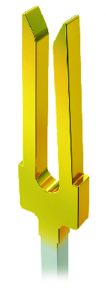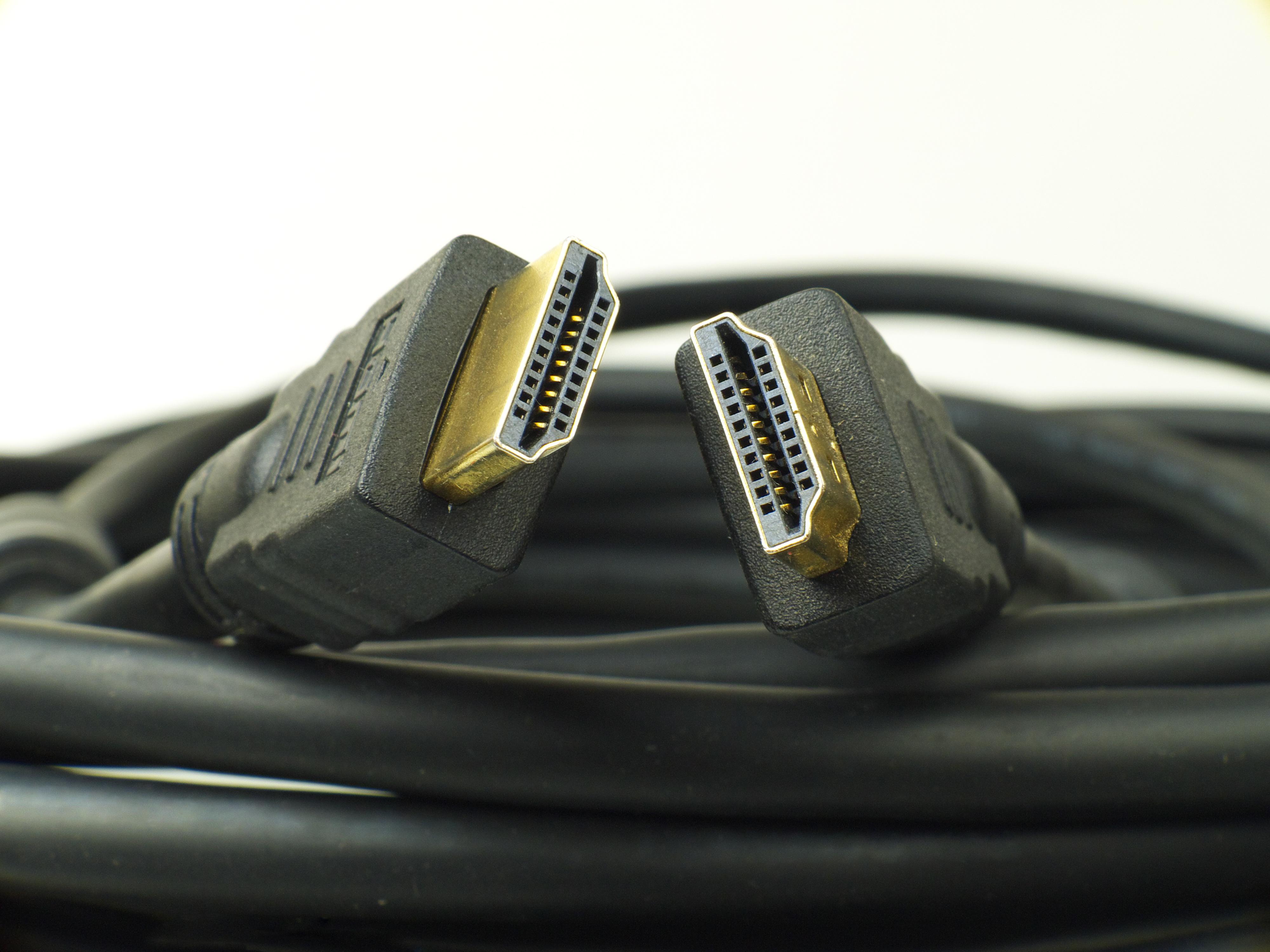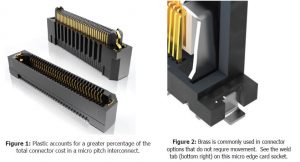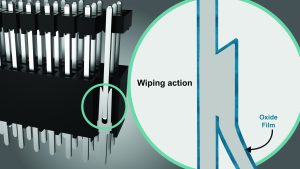What are the major costs to build a connector? Which of these are the bigger costs? In other words, what is the most expensive part of a connector? Excluding cable assemblies, the major costs in most board level connectors are the plastic body, the pins, plating on the pins, the labor to assemble it, and the packaging. Often, the bigger ticket items are the pins and the plating.
For example, on a micro pitch, high density interconnect product, the pin and plating may account for up to 30% of the total cost of the connector. But on a basic 2.54 mm centerline terminal strip (“header’), it can account for well over 50% of the total cost of the connector. (See Figure 1)
The relative size of the plastic body on a miniature, mold-to-position micro connector is almost always larger than the body on a basic cut-to-position strip-line connector. In other words, there’s more plastic in most micro-pitch interconnects, compared to bigger pitch strip headers. And, of course, the pins are going to cost more if you’re using gold plating.
Therefore, selecting the right pin and plating significantly impacts the cost of the connector system. This article is a quick overview of three different base metals commonly used in terminal pins and sockets, and it discusses different plating options available, what most customers use, and why. Disclaimer: The majority of examples in this article relate to Samtec interconnects, but I assume the cost principles apply to many other interconnect brands as well.
The three most common base metals for most board-to-board connectors are brass, beryllium copper, and phosphor bronze.
Brass
Brass is the least expensive of the three metals and has excellent electrical properties. Having said that, brass has low yield strength. Because of this, Samtec recommends not using brass in contacts. The concern is the brass beams on the socket will take a permanent set. Meaning, after cycling, the socket beams will spring back to their original position and the terminal beam will not properly mate with the socket.
Samtec uses brass components on some connector products, but they are for options what don’t bend or require movement, like the weld tabs on a micro edge card socket. (See Figure 2)
Beryllium Copper
Beryllium copper, while more expensive than most contact materials, provides the best combination of mechanical and electrical properties. Once formed and hardened, BeCu will retain its shape under a wide variety of conditions. And because BeCu springs back after cycling, it’s a great pin material for miniature connectors. So BeCu is good for rugged and high-cycle applications, and it’s good for micro connectors.
Phosphor Bronze
Phosphor bronze is stronger than brass and has better spring properties. But, its spring properties aren’t as good as BeCu, so it is not frequently used in micro pitch connectors. Phosphor bronze is well-suited for bigger contact systems with longer beams with more deflection (see Figure 3).
What Plating Option Do We Recommend?

Logos + Pin Illustrations for Tiger Eye, Tiger Beam, Tiger Buy and Tiger Claw Contacts on white background
Choosing the right plating is critical to the success of a connector system. Plating affects the connector’s performance, life cycle, quality, and cost. Designers frequently ask what plating finish we recommend? There are numerous considerations to take into account, but the best plating finish is whatever meets your system requirements, at the lowest cost. In other words, make sure the plating you select works and meets your quality design specifications, but don’t over-design on the plating.
Gold Plating
Gold is generally specified for high reliability, low voltage, or low current applications. Gold is used in high cycle applications because it’s rugged and has excellent wear properties. Samtec gold is alloyed with cobalt, which increases the hardness. We also recommend gold for hostile environments, because it will remain free of oxides which could cause an increase in contact resistance. Gold is a noble metal, which means it doesn’t react much to its environment.
Tin Plating
Tin is a lower cost alternative than gold, and has excellent solderability. Unlike gold, tin is not a noble metal. Tin plating starts to oxidize the moment it’s exposed to air. So a tin-plated contact system requires greater normal forces and a longer contact wipe area to break through this oxide film. (See Figure 4)
The bottom line is, tin is better for applications with fewer cycles because of the extra forces exerted on the contact, and simply because it’s a softer metal.
Normal Force
The distinction between gold and tin comes down to normal force. Gold requires a much lower amount of normal force compared to tin. With fine pitch connectors it is difficult to find the room and space to design a large, thick contact beam with lots of deflection in order to generate the normal force tin requires. So, due to physical size constraints, gold is often the only choice available. In other words, we would use tin if we could. Tin is used in the connector contact area where the proper normal force can be generated, and in benign environments. Tin is going to oxidize and therefore a higher amount of normal force and contact wipe is needed to break through the inherent layer of oxidation.
Selective Gold + Tin Plating Option
Selective gold-tin plating is Samtec’s most popular plating option because it provides designers with the best of both worlds. The contact area, the critical area where the contact interfaces the terminal pin and the signal is transferred, has the reliability of gold. The tail, which is soldered to the board, has the lower cost and solderability of tin.
Tin-Lead, Gold-Flashed Palladium Nickel
There are other plating options for specific applications. Two common examples include tin-lead plating and gold-flash palladium nickel. Tin-lead is used in military applications, and benefits include a low eutectic temperature, and the presence of lead inhibits the formation of tin whiskers. Gold-flashed palladium nickel is used for extremely high cycle applications. But, for most typical applications, gold, tin, or selective gold/tin plating is acceptable.
Summary
Gold is frequently used for high reliability, high cycle, low voltage applications. Tin is used for applications with fewer cycles, it’s less expensive, and it holds solder. Selective plating, with gold in the contact mating area and tin on the tail, is usually the best price/performance option.









